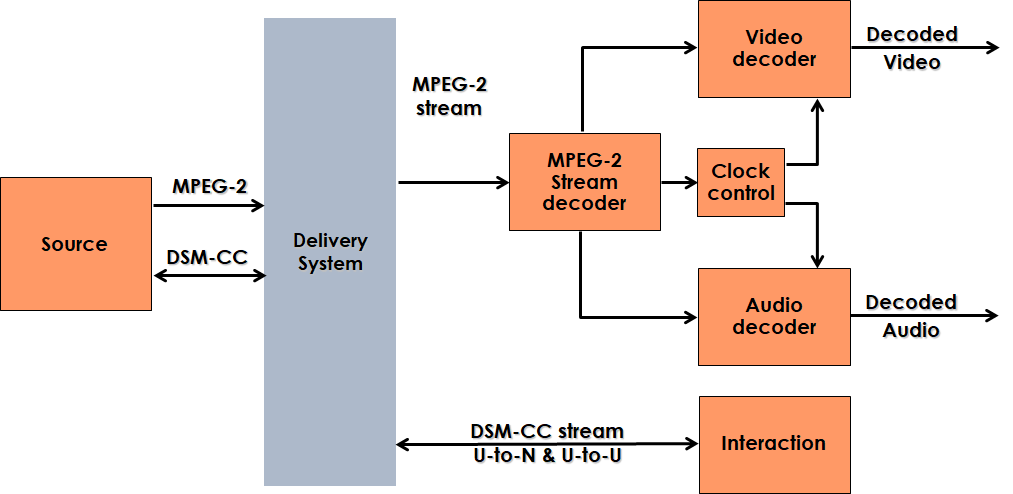MPEG-2 was a more complex beast to deal with. A digitised TV channel can yield 20-24 Mbit/s, depending on the delivery system (terrestrial/satellite broadcasting or cable TV). Digital stereo audio can take 0.2 Mbit/s and standard resolution 4 Mbit/s (say a little less with more compression). Audio could be multichannel (say, 5.1) and hopefully consume less bitrate for a total bitrate of a TV program of 4 Mbit/s. Hence the bandwidth taken by an analogue TV program can be used for 5-6 digital TV programs.
Figure 52 – Model of the MPEG-2 standard
The fact that digital TV programs part of a multiplex may come from independent sources and that digital channels in the real world are subject to errors force the design of an entirely different Systems layer for MPEG-2. The fact that users need to access other data sent in a carousel, that in an interactive scenario (with a return channel) there is a need for session management and that a user may interact with a server forced MPEG to add a new stream for user-to-network and user-to-user protocols.
In conclusion the MPEG-2 model is a natural extension of the MPEG-1 model (superficially, the DSM-CC line, but the impact is more pervasive).
The official title of MPEG-2 is Generic coding of moving pictures and associated audio information. It was originally intended for coding of standard definition television (MPEG-3 was expected to deal with coding of High Definition Television). As the work progressed, however, it became clear that a single format for both standard and high definition was not only desirable but possible. Therefore, the MPEG-3 project never took off.
The standard is not specific of a video resolution (this was already the case for MPEG-1 Video) but rationalises the notion of profiles, i.e. assemblies of coding tools and levels a notion that applies to, say, resolution, bitrate etc. Profiles and levels have subsequently adopted in most MPEG standardisation areas.
The standard is composed of 10 parts, some of which are
- Part 1 – Systems specifies the Systems layer to enable the transport of a multichannel digital TV stream on a variety of delivery media (link)
- Part 2 – Video specifies the video coding algorithm. Video is interlaced and may have a wide range of resolutions with support to scalability and multiview in appropriate profiles (link)
- Part 3 – Audio specifies a MPEG-1 Audio backward-compatible multichannel audio coding algorithm. This means that an MPEG-1 Audio decoder is capable of extracting and decoding an MPEG-1 Audio bitstream (link)
- Part 6 – Extensions for DSM-CC specifies User-to-User and User-to-Network protocols for both broadcasting and interactive applications. For instance DSM-CC can be used to enable such functionalities as carousel or session set up (link)
- Part 7 – Advanced Audio Coding (AAC) specifies a non-backward compatible multichannel audio coding algorithm. This was done because backward compatibility imposes too big a penalty for some applications, e.g. those that do not need backward compatibility (link), the first time MPEG was forced to develop two standards for apparently the same applications.
| Table of contents | ◄ | 13.1 MPEG-1 | █ | 13.3 MPEG-4 | ► |
